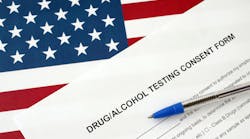They say time is like a roll of toilet paper. The closer you get to the end, the quicker it goes. Everyone who reads this column can relate to that statement, and the more you think about it, the more you will scratch your head and tend to agree. Time flies. Can you recall where you were, or for that matter, what you were doing on Dec. 4, 2015?
On that particular date, my son was in fourth grade; today, he is deciding where he wants to go to college. The December date is so interesting because it marks when President Obama signed the Fixing America’s Surface Transportation Act into law. Even more critical was the language included in that law, specifically Section 5402, titled “Drug-Free Commercial Drivers.” This language called for the ability to use hair testing as an acceptable alternative to urine testing for DOT drug testing protocols.
A lot has happened since that day over eight years ago. Two other presidents have taken office. We have gone through a global pandemic, and even the Pentagon has released three videos regarding UFOs. The FAST Act was signed so long ago that we are even operating under a new infrastructure bill. What we don’t have is a rule that would allow motor carriers to use hair testing as an alternative measure for pre-employment screening purposes and have those results recorded in the Drug & Alcohol Clearinghouse.
Imagine explaining to your boss that it has taken eight years to complete a job and are still far from finishing it. And a lot has happened over that period.
Since December 2015, seven large trucking companies in 2021 gave prospective drivers two pre-employment drug tests: the DOT-required urinalysis and the hair follicle test. This process was conducted among 88,021 licensed truck drivers who applied for jobs at these companies. The results were astounding. Using urinalysis, 403 drivers had illegal drugs in their systems; using hair tests, 4,362 drivers were detected for a regular pattern of illicit drug use, uncovering an astonishing 11 times more drivers than the DOT-prescribed urine test.
See also: FMCSA application reignites hair-testing debate
It doesn’t stop there, either. Research conducted by the University of Central Arkansas in 2022 revealed that as many as nine out of 10 truck drivers who use illegal drugs escape detection with the federally required urinalysis. Even more recently, a new study in the Transportation Journal published by Pennsylvania State University Press acknowledges that thousands of truckers are escaping detection because the industry is reliant on urine rather than hair for determining drug usage.
We can cite studies as much as we want regarding the success rate of hair testing over urine-based testing for pre-employment drug screens. We can even praise those motor carriers that have adopted this measure for their use. However, until a rule or regulatory guidance allows the results to be submitted to the Drug & Alcohol Clearinghouse, thousands of drivers could have likely circumvented the system and moved on to another unsuspecting motor carrier.
I get it. There has been “some” movement on this issue, and proposed guidance would have required a follow-up urine-based test to confirm a positive hair follicle test, which brings us back to where we started. Watered-down guidance to justify a hair follicle test is merely checking a box rather than making a strong decision to let hair follicle testing stand on its own.
The industry has even adopted oral fluid drug testing as a new rule. But we continue to wait for the agency to certify two laboratories for this rule to become effective. The oral fluid drug testing rule took effect June 1 but hasn’t been active because of the two-labs caveat.
The reality is that the industry is doing a much better job of detecting drugs in the system of professional drivers and should be commended for taking such a proactive approach toward combating this issue. As an industry, however, we cannot wait any longer for a rule blessed nearly nine years ago because that time is up.
Let’s advocate for this rule to make sense, cross the finish line, and allow the results to be entered into the clearinghouse where everyone can benefit.



